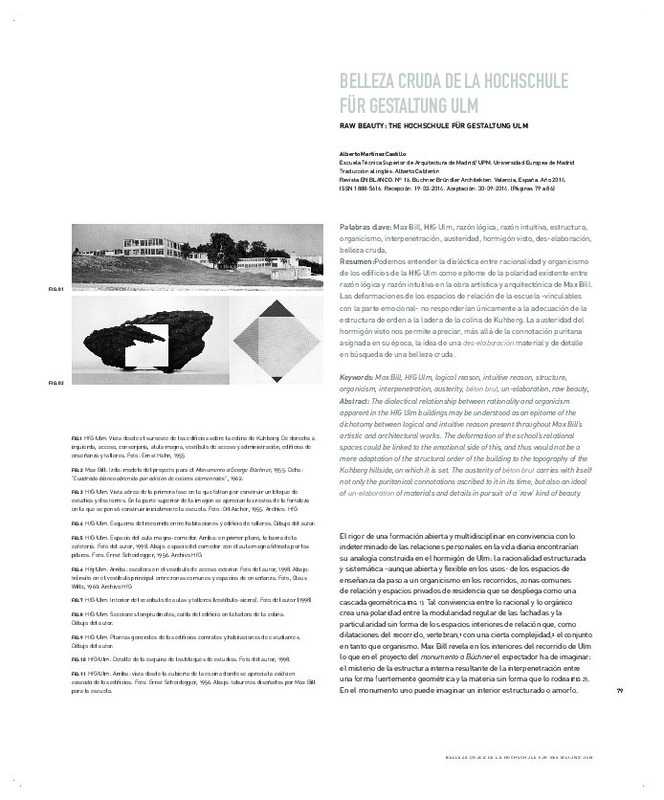JavaScript is disabled for your browser. Some features of this site may not work without it.
Buscar en RiuNet
Listar
Mi cuenta
Estadísticas
Ayuda RiuNet
Admin. UPV
Belleza cruda de la Hochschule Für Gestaltung Ulm
Mostrar el registro sencillo del ítem
Ficheros en el ítem
| dc.contributor.author | Martinez Castillo, Alberto
|
es_ES |
| dc.date.accessioned | 2017-11-30T11:35:23Z | |
| dc.date.available | 2017-11-30T11:35:23Z | |
| dc.date.issued | 2014-12-20 | |
| dc.identifier.issn | 1888-5616 | |
| dc.identifier.uri | http://hdl.handle.net/10251/91677 | |
| dc.description.abstract | [EN] The dialectical relationship between rationality and organicism apparent in the HfG Ulm buildings may be understood as an epitome of the dichotomy between logical and intuitive reason present throughout Max Bill’s artistic and architectural works. The deformation of the school’s relational spaces could be linked to the emotional side of this, and thus would not be a mere adaptation of the structural order of the building to the topography of the Kuhberg hillside, on which it is set. The austerity of béton brut carries with itself not only the puritanical connotations ascribed to it in its time, but also an ideal of un-elaboration of materials and details in pursuit of a ‘raw’ kind of beauty. | es_ES |
| dc.description.abstract | [ES] Podemos entender la dialéctica entre racionalidad y organicismo de los edificios de la HfG Ulm como epítome de la polaridad existente entre razón lógica y razón intuitiva en la obra artística y arquitectónica de Max Bill. Las deformaciones de los espacios de relación de la escuela -vinculables con la parte emocional- no responderían únicamente a la adecuación de la estructura de orden a la ladera de la colina de Kuhberg. La austeridad del hormigón visto nos permite apreciar, más allá de la connotación puritana asignada en su época, la idea de una des-elaboración material y de detalle en búsqueda de una belleza cruda. | es_ES |
| dc.language | Español | es_ES |
| dc.language | Inglés | es_ES |
| dc.publisher | Universitat Politècnica de València | |
| dc.relation.ispartof | EN BLANCO. Revista de Arquitectura | |
| dc.rights | Reconocimiento - No comercial (by-nc) | es_ES |
| dc.subject | Max Bill | es_ES |
| dc.subject | HfG Ulm | es_ES |
| dc.subject | Razón lógica | es_ES |
| dc.subject | Razón intuitiva | es_ES |
| dc.subject | Estructura | es_ES |
| dc.subject | Organicismo | es_ES |
| dc.subject | Interpenetración | es_ES |
| dc.subject | Austeridad | es_ES |
| dc.subject | Hormigón visto | es_ES |
| dc.subject | Des-elaboración | es_ES |
| dc.subject | Belleza cruda | es_ES |
| dc.subject | Logical reason | es_ES |
| dc.subject | Intuitive reason | es_ES |
| dc.subject | Structure | es_ES |
| dc.subject | Organicism | es_ES |
| dc.subject | Interpenetration | es_ES |
| dc.subject | Austerity | es_ES |
| dc.subject | Béton brut | es_ES |
| dc.subject | Un-elaboration | es_ES |
| dc.subject | Raw beauty | es_ES |
| dc.title | Belleza cruda de la Hochschule Für Gestaltung Ulm | es_ES |
| dc.title.alternative | Raw beauty: the Hochschule Für Gestaltung Ulm | es_ES |
| dc.type | Artículo | es_ES |
| dc.date.updated | 2017-11-30T10:39:25Z | |
| dc.identifier.doi | 10.4995/eb.2014.5812 | |
| dc.rights.accessRights | Abierto | es_ES |
| dc.description.bibliographicCitation | Martinez Castillo, A. (2014). Belleza cruda de la Hochschule Für Gestaltung Ulm. EN BLANCO. Revista de Arquitectura. 6(16):79-86. https://doi.org/10.4995/eb.2014.5812 | es_ES |
| dc.description.accrualMethod | SWORD | es_ES |
| dc.relation.publisherversion | https://doi.org/10.4995/eb.2014.5812 | es_ES |
| dc.description.upvformatpinicio | 79 | es_ES |
| dc.description.upvformatpfin | 86 | es_ES |
| dc.type.version | info:eu-repo/semantics/publishedVersion | es_ES |
| dc.description.volume | 6 | |
| dc.description.issue | 16 | |
| dc.identifier.eissn | 2445-1215 | |
| dc.description.references | BILL, Max. "FORM, A Balance Sheet of Mid-Twentieth-Century Trends in Design" . Verlag Karl Werner. Basel. 1952 | es_ES |
| dc.description.references | ORTEGA Y GASET, José., "La deshumanización en el arte". Ediciones de la Revista de Occidente. Colección El Arquero. 1ª Ed. 1925. 11ª Ed. 1976 | es_ES |
| dc.description.references | SPLITZ, René: "hfg ulm, the view behind the foreground 1963-1968", Edition Axel Menges, Stuttgart/London, 2002. Inglés. | es_ES |
| dc.description.references | Von MOOS, Stanislaus en "Recycling Max Bill", "minimal tradition, max bill and simple architecture", Lars Müller Publishers, 1996, | es_ES |








